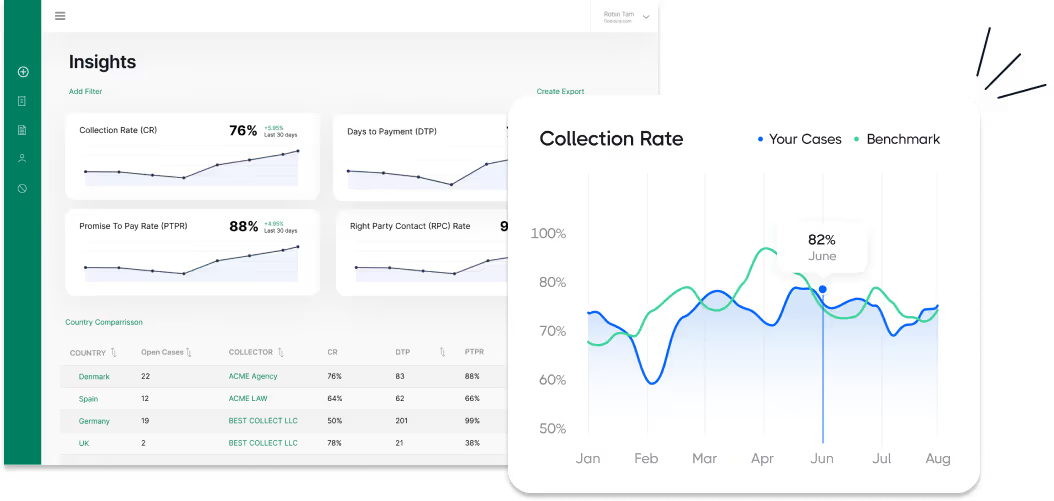Debt Collection Services in Estonia. Hire a Local Agency or Learn How It Works
Read our 2025 guide for DIY debt collection in Estonia, or instantly connect with a trusted debt collection agency in Estonia via Debitura’s platform. Zero upfront fees, fast recovery, complete transparency.


Need a Debt Collection Agency in Estonia?
Struggling with unpaid invoices in Estonia? Debitura instantly routes your claim to locally trusted specialists who understand Estonia’s unique legal landscape—from the amicable “maksekäsu kiirmenetlus” (payment order procedure) to enforcement through local bailiffs.
- Zero Risk, No Upfront Fees: You only pay a success fee if your claim is recovered.
- Immediate Estonian Expertise: Local experts swiftly initiate recovery according to Estonian business norms and legal standards.
- Nationwide Proven Results: Specialists experienced in Estonia’s courts and business culture, ensuring effective collection outcomes.
- Complete Transparency: Follow your claim's progress live, in real-time, from initial reminder to final payment.




Need a Debt Collection Agency in Estonia?
Struggling with unpaid invoices in Estonia? Debitura instantly routes your claim to locally trusted specialists who understand Estonia’s unique legal landscape—from the amicable “maksekäsu kiirmenetlus” (payment order procedure) to enforcement through local bailiffs.
- Zero Risk, No Upfront Fees: You only pay a success fee if your claim is recovered.
- Immediate Estonian Expertise: Local experts swiftly initiate recovery according to Estonian business norms and legal standards.
- Nationwide Proven Results: Specialists experienced in Estonia’s courts and business culture, ensuring effective collection outcomes.
- Complete Transparency: Follow your claim's progress live, in real-time, from initial reminder to final payment.
Your Quick Guide to Debt Collection in Estonia: 2025 Version
Why you can trust this guide
At Debitura, we uphold the highest standards of impartiality and precision to bring you comprehensive guides on international debt collection. Our editorial team boasts over a decade of specialized experience in this domain.
Questions or feedback? Email us at contact@debitura.com — we update this guide based on your input.
Debitura By the Numbers:
- 10+ years focused on international debt collection
- 100+ local attorneys in our partner network
- $100M+ recovered for clients in the last 18 months
- 4.97/5 average rating from 600+ client reviews
Expert-led, locally validated
Written by Robin Tam (16 years in global B2B debt recovery). Every page is reviewed by top local attorneys to ensure legal accuracy and practical steps you can use.
Contributing local experts:
Last updated:
Conquering debt collection in Estonia can feel intimidating. With Debitura, ease this journey, leveraging the power of local knowledge combined with international experience. Our guide prepares you to effectively manage these challenges, becoming your essential companion in Estonian debt recovery.
Unpacking the Key Contributors to Estonia's Debt Recovery
Navigating Estonia's debt recovery landscape requires a firm grasp of the key contributors' roles – from debt collection agencies and bailiffs to legal experts. Understanding their unique roles in the stringent Estonian legal framework ensures a streamlined debt recovery process.
Debt Collection Agencies (Inkassofirmad)
Licensed under the Credit Collection and Purchasers Act, Estonian debt collection agencies handle pre-legal recovery efforts. They operate within the Law of Obligations Act and the Debt Collection Act, ensuring ethical practices. Their role includes sending demand letters, making phone calls, and negotiating repayment plans. If these efforts fail, the case may proceed to legal action.
Lawyers (Advokaadid)
Legal professionals become essential when disputes arise or legal proceedings are necessary. They assist in drafting legal documents, representing creditors in court, and navigating the complexities of Estonian debt recovery laws.
Bailiffs (Kohtutäiturid)
Court-appointed bailiffs enforce judgments by seizing assets, garnishing wages, or freezing bank accounts. They act only upon a valid court order and follow procedures outlined in the Code of Enforcement Procedure.
Understanding Debt Collection Laws in Estonia
Estonia’s debt recovery framework ensures fairness and efficiency, balancing creditor rights with debtor protections.
Civil Court Structure
- County Courts (Maakohus): First instance for civil cases, including debt disputes.
- Circuit Courts (Ringkonnakohus): Handle appeals from county courts.
- Supreme Court (Riigikohus): Final appellate authority and constitutional review
Key Legislation in Estonia
- Law of Obligations Act: Governs contractual relationships and obligations.
- Code of Civil Procedure: Outlines procedures for civil litigation, including debt claims.
- Debt Restructuring and Debt Protection Act: Provides mechanisms for individuals to restructure debts and avoid bankruptcy.
Consumer Protection from Unfair Collection Practices in Estonia
Estonian law safeguards consumers against unfair collection practices:
- Collection agencies must provide clear documentation of debts.
- Limits are placed on collection costs to prevent excessive charges.
- Consumers can dispute claims through the Consumer Disputes Committee.
Amicable Debt Collection in Estonia: Step-by-Step
Amicable debt collection is Estonia's recommended first step for recovering unpaid debts, offering a fast, cost-effective alternative to court proceedings. Understanding local legal specifics, such as the statute of limitations and interest charges, ensures effective recovery.
When to Use Amicable Debt Collection in Estonia:
- When invoices remain unpaid after due dates.
- To maintain good business relationships.
- Before initiating costly legal actions.
Important Legal Considerations:
- Statute of Limitations: Standard claims expire after 3 years; intentional breaches extend this period to 10 years.
- Interest on Late Payments: If no contract terms specify otherwise, statutory late-payment interest is ECB's refinancing rate plus 8%.
Step-by-Step Process:
- Formal Demand Letter ("Nõudekiri"): Clearly state the debt amount, payment terms, and possible legal consequences.
- Direct Debtor Communication: Engage via phone or email to clarify details and encourage prompt resolution.
- Negotiate Repayment Terms: Agree upon realistic, mutually acceptable payment arrangements.
- Payment Monitoring & Reminders: Regularly track payments and promptly remind debtors of obligations.
- Issue Final Notice: Provide a final written warning before considering legal proceedings.
If amicable collection does not yield results, Estonia’s judicial debt recovery process becomes the next logical step.
Judicial Debt Collection in Estonia
When amicable methods fail, judicial debt collection provides a structured legal pathway to enforce unpaid claims through Estonia’s court system.
- Court Order Required: Judicial recovery mandates obtaining an enforceable court judgment.
- Streamlined Small Claims: Claims under €6,400 qualify for Estonia’s simplified "Payment Order" procedure.
- Enforcement by Bailiffs: After judgment, licensed Estonian bailiffs execute asset seizures and salary attachments.
How to get a court order:
- Payment Order ("Maksekäsu kiirmenetlus"): Quick, digital procedure for undisputed debts under €6,400.
- Regular Court Proceedings: Necessary for complex or disputed cases, managed by Estonia's County Courts.
Timeframe & Cost:
- Duration: Typically 3–9 months depending on the debtor’s cooperation and case complexity.
- Costs: Court fees vary (€75–€325 for small claims), and additional legal costs are proportionate to the claim’s complexity and value.
Debt Enforcement in Estonia
After securing a court judgment, creditors in Estonia can enforce their claims through licensed bailiffs.
- Timeframe: Enforceable for up to 10 years after judgment.
- Role of Bailiffs: Execute asset seizures, wage garnishment, or bank account freezes.
- Debtor Protection: Essential assets and minimum income levels protected from seizure.
Enforcement Process Overview:
- Initiation: The creditor submits an application and the enforceable title (e.g., court judgment) to a bailiff.
- Notification: The bailiff notifies the debtor and may grant a voluntary compliance period.
- Asset Seizure: If the debtor fails to comply, the bailiff can seize assets, including bank accounts and property.
- Public Auction: Seized assets may be sold at public auction to satisfy the debt.
- Distribution of Proceeds: Funds recovered are distributed to the creditor after deducting enforcement costs.
Insolvency Proceedings in Estonia
When debtors lack sufficient assets, creditors may initiate insolvency proceedings as a last resort.
- Initiation: Creditors file bankruptcy petitions at county courts.
- Trustee Role: Court-appointed trustee manages asset liquidation and creditor payments.
- Recovery Potential: Typically around 40% recovery rate; proceedings usually conclude within three years.
Insolvency Process Overview:
- Filing a Petition: A creditor submits a bankruptcy petition to the county court where the debtor is registered.
- Court Assessment: The court evaluates the petition and, if justified, declares bankruptcy.
- Trustee Management: A court-appointed trustee takes control of the debtor's assets, assesses liabilities, and manages the estate.
- Asset Liquidation: The trustee liquidates assets to satisfy creditor claims, following the priorities set by law.
- Proceeding Conclusion: After asset distribution, the proceedings conclude, and any remaining debts may be discharged, depending on the case specifics.
Find a Local Debt Collection Lawyer
Need court-ready representation? Share your case once and receive up to three proposals from vetted litigation attorneys—free, fast, and with no commitment.
- Verified specialists
- Quotes in 24 h, no hidden fees
- Fair, pre-negotiated rates

Julianus Inkasso OÜ is a premier debt recovery agency in Tallinn offering effective Debt Collection services in Estonia, known for nearly three decades of expertise in the Baltics, founded in 2000, with accolades and memberships enhancing its trusted reputation.

Narlex Law Firm is a premier law firm in Tallinn offering effective Debt Collection services in Estonia, established in 2011, with over 30 years of professional experience and membership in the Estonian Bar Association, making it the trusted partner for debt recovery.





.svg)

.webp)
.png)

.png)
.svg)












.webp)